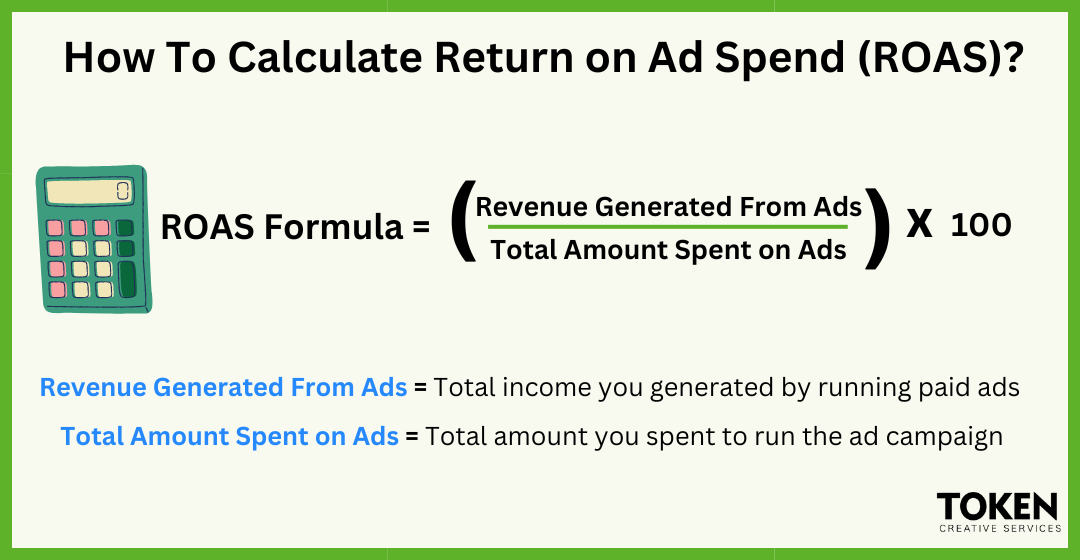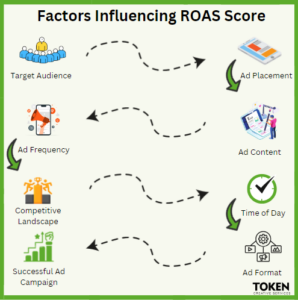ROAS Calculator
Back Your Advertisement Campaign with a Data-Driven Budget Plan
Maximize Your Advertising ROI with Our Free Ad Budget Planner
Through extensive market research and testing, we have determined industry averages for conversion rates and cost per click.
Using these numbers we have built this simple tool to help calculate an effective monthly ad spend to achieve your desired results.
Simply select your industry from the drop down list, enter your desired number of conversions per month, and hit calculate.
If your industry does not appear on the list please feel free to reach out and we can work with you 1 on 1 or include your industry here for future use.
Step 1

Step 2

Step 3

Step 4



Your Industry
Desired Conversion #
Suggested Ad Spend
$0
What is ROAS? Measure Paid Ad Campaign's Effectiveness with ROAS Calculator
Are you investing in advertising campaigns but struggling to measure their impact on your business? Not knowing whether your hard-earned money is really paying off can be frustrating. This is where Return on Ad Spend (ROAS) comes in. ROAS is a critical metric that allows you to determine how much revenue you earn for every dollar you spend on advertising. It's an essential metric for any business owner or marketer who wants to evaluate their advertising strategy's effectiveness.
Our ROAS Calculator is a simple yet powerful tool that allows you to calculate your ROAS score instantly, taking the guesswork out of your advertising decisions. All you need to do is input your advertising cost and revenue; our tool will do the rest. You'll get a comprehensive analysis of your campaign's effectiveness and actionable insights to improve your ROI. Armed with this valuable information, you can optimize your ad spend, boost revenue, and ultimately grow your business.
Whether you're an experienced marketer or just starting out, our ROAS Calculator is an essential tool for driving the success of your business. Try it out today and see its impact on your bottom line.
What is a good ROAS Score?
This question plagues many marketers, but the answer is simple: it depends on your industry, business goals, and advertising strategies. Generally, a good ROAS score is considered to be around 4:1 or higher. This means that for every $1 spent on advertising, you generate $4 in revenue. Always keep in mind that this number can vary widely depending on the industry and the specific goals of the advertising campaign.
For example, e-commerce businesses may aim for a higher ROAS score of 5:1 or higher, while service-based businesses may aim for a lower score of 2:1 or 3:1. Ultimately, the best ROAS score for your business will depend on your specific goals, budget, and industry benchmarks.
Terms You Need to Know When Planning Ad Budget with ROAS Calculator
Monthly Budget- It is the total amount you will be spending every month for paid ad campaigns. You can check the estimated ad spend for desired conversions using our ad budget calculator.
Cost Per-Thousand Impressions (CPM)- The cost of displaying an ad to one thousand viewers. This is often used as a standard measurement for online advertising.
The formula for CPM = (Total Cost of Ad Campaign / Total Number of Impressions) x 1000
Cost Per Click (CPC)- The cost of each click on an ad. This is used in pay-per-click advertising.
The formula for CPC = Total Ad Spend / Total No. of Clicks
Conversion Rate- The percentage of viewers who take the desired action, such as making a purchase or filling out a form, after clicking on an ad.
The formula for Conversion Rate = (Number of Conversions / Number of Clicks) x 100%
Click-Through Rate (CTR)- The percentage of viewers who click on an ad after seeing it.
The formula for CTR = (Number of clicks / Number of impressions) x 100%
Customer Lifetime Value (CLTV)- CLTV is a term used to describe the estimated total revenue a business can expect to generate from a single customer over the entire duration of their relationship with the company.
The formula for CLTV = (Average Purchase Value x Average Number of Purchases Made in Customer Lifespan)
Return on Investment (ROI)- The amount of revenue generated by an ad campaign compared to the amount spent on it. It is often misjudged to be the same as ROAS.
The formula for ROI = (Total Ad Revenue - Ad Spend) x 100
Frequency- The number of times an ad is displayed to the same viewer.
Impressions- The number of times an ad is displayed.
Reach- The number of unique viewers who see an ad.
Understanding the ROAS Calculation Process of our Tool for Estimating Ad Campaign Budgets
Note: Our calculator provides estimated costs, not exact amounts.
Assuming you're in the technology industry and spending $10,000 per month on advertising, you get:
- 250 clicks per month at a 5% click-through rate (CTR), so your cost-per-click is $40
- 10 of those clicks turn into customers at a 4% conversion rate
- Each customer spends $10,000 on your products or services over their lifetime
To calculate your ROAS first you need to calculate the total revenue:
Total revenue = (No. of Conversions x CLTV)
In this case, total revenue = (10 x $10,000) = $100,000
Now use the ROAS formula: ROAS = (Total Revenue / Ad Spend)
ROAS = ($100,000 / $10,000) = 10
In case, you need to convert the ROAS to a percentage: ROAS % = (ROAS x 100)
ROAS % = (10 x 100) = 1000%
A ROAS of 10 is considered very good, as it means you're earning $10 in revenue for every $1 spent on advertising.
Remember, a ROAS score below 1 or 100% is considered poor, as it indicates that your business is not making any profit from the paid ad campaign and needs a re-evaluation of strategies.

Key Factors Affecting the ROAS Metric
There are several factors that can influence the ROAS score:
- Target Audience: The right target audience is crucial to achieving a high ROAS. If you're targeting the wrong or irrelevant audience, you'll likely see a lower conversion rate and a lower ROAS.
- Ad Placement: The placement of your ad can impact the ROAS. Ads in more visible locations tend to have a higher click-through rate, which can lead to a higher ROAS.
- Ad Content: Engaging and relatable ad content tends to have a higher click-through rate and conversion rate, resulting in a higher ROAS.
- Ad Frequency: Showing ads too frequently can result in ad fatigue and a lower conversion rate, leading to lower ROAS.
- Competitive Landscape: The competitive landscape can impact the ROAS, with more competition increasing the cost of advertising and lowering the ROAS.
- Time of Day: Showing ads during peak hours when the target audience is most active can lead to a higher click-through rate and conversion rate, resulting in a higher ROAS.
- Ad Format: Different ad formats may perform differently and result in different ROAS values, so it's worth experimenting with different formats to see which work best for your business.

Optimize Your Ad Spend and Grow Your Business
Our ROAS Calculator provides valuable insights and recommendations to help you optimize your ad spend and grow your business. Whether you are targeting the right audiences, optimizing your ad creative, or measuring the performance of your campaigns, our tool delivers essential insights to improve your marketing strategy and boost your ROAS.
Ready to start maximizing your ROAS? Simply input your data into our free ROAS Calculator and discover the power of your advertising returns today.
How to Obtain Your ROAS Goal?
- Set Clear Goals: Define the desired ROAS ratio (e.g., 500%) for revenue gained per ad spend.
- Track Conversions: Install tracking tools to monitor user actions valuable to your business.
- Calculate Current ROAS: Revenue from ads ÷ spend on ads = baseline ROAS.
- Analyze Data: Identify top-performing elements and underperforming areas in campaigns.
- Optimize High-Performing Campaigns: Allocate budget to successful campaigns; learn from attributes driving success.
- Adjust Underperforming Campaigns: Revise ads, targeting, or keywords based on analysis to improve performance.
- A/B Testing: Test different ad variations to identify which yields better results.
- Landing Page Optimization: Optimize landing pages for relevance, user-friendliness, and conversions.
- Budget Allocation: Focus resources on consistently high ROAS campaigns; account for longer conversion cycles.
- Regular Monitoring: Continuously track campaign performance; adapt strategies to changing trends.
- Data-Driven Approach: Base decisions on metrics like CTR, conversion rates, and revenue generated.
- Refine and Iterate: Ongoing process; use data insights to improve strategies and campaign performance.
Frequently Asked Questions (FAQs)
Q: What is ROAS?
A: ROAS stands for Return on Ad Spend. It is a measurement used to determine the effectiveness of your advertising campaigns by calculating the revenue generated from your campaigns concerning your ad spend.
Q: What is the Return on Ad Spend calculation formula?
A: The Return on Ad Spend (ROAS) calculation formula is a metric used to evaluate the effectiveness of an advertising campaign by measuring the revenue generated compared to the cost of the campaign. The calculation formula for ROAS is:
ROAS = Revenue Generated from Ad Campaign / Cost of Ad Campaign
Q: Is ROAS the same as ROI?
A: ROAS (Return on Ad Spend) and ROI (Return on Investment) are related but different metrics. ROAS measures the revenue generated by a campaign divided by the cost of the campaign, while ROI measures the net profit generated by a campaign divided by the cost of the campaign. ROI takes into account all expenses and revenue generated, while ROAS only looks at advertising spend and revenue.
Q: How does the ROAS Calculator work?
A: The ROAS Calculator calculates the effectiveness of your advertising campaigns. You simply input your ad spend, and the revenue generated from your campaigns, and our tool will calculate your ROAS.
Q: Is the ROAS Calculator easy to use?
A: Yes, our ROAS Calculator is user-friendly and simple to use. You can quickly input your data and get your ROAS calculation with just a few clicks.
Q: Can the ROAS Calculator help me optimize my ad spend?
A: Yes, our ROAS Calculator provides valuable insights and recommendations to help you optimize your ad spend and improve your marketing strategy.
Q: What if my ROAS is below 100 percent?
A: If your ROAS is below 100 percent, it means that your advertising spend is not generating enough revenue to cover the cost of the campaign. In this case, you may need to re-evaluate your targeting, messaging, and other factors to improve the effectiveness of your campaign. The specific percentage threshold for what constitutes a "poor" ROAS can vary depending on the industry and campaign objectives. However, in general, a ROAS below 100% indicates that the campaign is not generating a positive return on investment.
Q: How can I improve my ROAS score using your Calculator tool?
A: Our ROAS Calculator tool provides you with valuable insights into the performance of your advertising campaigns. By analyzing key metrics such as your advertising spend for target conversions, you can plan your ad budget better. Always look for areas for improvement and make data-driven decisions to optimize your advertising campaigns for maximum ROI. Here are a few tips on how to improve your ROAS score using our tool:
- Focus on your target audience
- Optimize your ad creative
- Monitor your ad placements
- Continuously analyze your data
Q: What is break-even ROAS?
A: Break-even ROAS (Return on Ad Spend) is the minimum ROAS that a business needs to achieve in order to break even on its advertising spend. In other words, it is the ROAS at which the revenue generated from advertising is equal to the cost of advertising, resulting in zero profit or loss.
Q: How to calculate break-even ROAS?
A: To calculate the break-even ROAS (Return on Advertising Spend), you need to divide your total advertising costs by your total revenue.
Break-even ROAS = Total Advertising Costs / Total Revenue
For example, if your total advertising costs are $10,000 and your total revenue is $50,000, your break-even ROAS would be:
Break-even ROAS = $10,000 / $50,000
Break-even ROAS = 0.2 or 20%
This means that for every $1 you spend on advertising, you need to generate $1.20 in revenue to break even.